Innovation lifecycle refers to the stages that ideas go through before they are released as shippable innovations. Here’s our process for taking ideas from collection to implementation:
Ideation: Innovations start out as ideas that could potentially benefit the organization. For example, a customer shares an idea for improving the user experience, or an employee suggests a way to automate a tedious process.
Idea improvement: Ideas then undergo an improvement step, where everyone inside the organization can view them and use their expertise to recommend improvements. This polishes ideas using the collective intelligence of participants from across the organization.
Idea evaluation: Idea evaluators will filter through ideas using evaluation models and either greenlight them or send them back to the original author for further refinement.
Idea prioritization: Stakeholders and other decision makers vote on the order in which to pursue ideas.
Idea validation: If there’s a lot of uncertainty around an idea, department managers will assemble a validation team and have them run experiments to learn if it should be implemented. These experiments may include creating a prototype, running a financial risk analysis, or building a business case.
Implementation: For low-risk, high-certainty ideas where most validation work is complete, innovation teams pass ideas onto the project management office for implementation. However, for revolutionary ideas that require a lot of validation even after implementation, innovation teams work alongside the project management office to continue refining the innovation.
Impact tracking: Finally, organizations will track KPIs like sales figures, adoption rates, and NPS to understand the impact of the innovation.
This article discusses the stages of the innovation lifecycle in more depth, including common mistakes we see organizations make during each stage and how you can avoid them.
In addition, we explain why centralizing innovation efforts within an innovation management platform is more effective than coordinating inside several different tools (spreadsheets, survey tools, project management tools, etc.).
To learn more about how you can support innovations from ideation to impact tracking, schedule a free consultation with our team.
1. Ideation
The lifecycle of an innovation begins with someone submitting an idea they believe can help the organization. This idea could be as simple as using accounting software to speed up payroll or more complex as transitioning to a new pricing model.
Many organizations approach ideation by creating a Slack channel or Google Form where participants can share any idea they have. However, based on our experience doing innovation consulting for the last 15 years, this approach has significant constraints.
Because employees aren’t informed and updated on the organization's priorities and don’t understand what ideas are needed, they submit ideas relevant to their everyday job obligations rather than areas the organization wants to innovate around.
Let’s say a hospital’s priority is improving the patient waiting room experience. If the hospital doesn’t educate participants about this priority, it’s unlikely participants will submit relevant ideas.
Instead, it’s best practice to inform participants about the types of ideas that are needed and keep them in the loop if priorities change or new priorities emerge.
A good way to do this is to utilize Innovation Challenges to source ideas. Innovation Challenges are postings (with deadlines) asking employees and outside participants to submit ideas that align with the innovation strategy.
The benefits of running challenges over open calls for ideas are:
You receive more relevant ideas: Employees understand what the organization focuses on, so they only submit relevant ideas.
You receive higher-quality ideas: Organizations can elaborate on the priority at hand by adding content such as videos, images, and FAQs to each challenge. This enables employees to clearly understand the priority, yielding higher-quality ideas.
There’s more urgency among participants: Because challenges have deadlines, participants are encouraged to get involved quickly. Always open Slack channels and Google Forms don’t produce this urgency.
How InnovationCast Helps Organizations Collect Ideas Relevant to Their Priorities
We built InnovationCast with Innovation Challenges, allowing organizations to source ideas specific to their priorities.
Innovation managers and stakeholders can create a challenge around a topic they need ideas on. InnovationCast will then automatically notify all participants via email and encourage them to brainstorm and submit relevant ideas.

A point to note here is that few challenge software offer guidance on the information needed to create effective challenges, i.e., challenges that source high-quality ideas. They leave you to figure that out on your own.
Instead, we provide checklists and tutorials on what information we see in the most effective challenge postings. Depending on the topic, we suggest attaching different resources: customer interviews, survey results, market data, or competitor information. This ensures that your challenges contain the context to source the best possible ideas.
Additionally, we have several themes built into InnovationCast that you can use to create beautiful challenge postings. You don’t have to build a web page from scratch or rely on basic Google Form designs. However, if none of our themes stand out to you, our team will create a theme around your brand identity.
Read more: 5 Best Ideation Platforms (2025 Review Guide)
2. Idea Improvement
Once ideas are submitted, many organizations send them directly to idea evaluators, who determine whether they should be implemented or cut loose.
However, most ideas — even the strongest — are incomplete in their initial drafts and require further refinement.
We found that implementing an improvement step where everyone in the organization can review ideas and apply feedback is most effective. Employees from customer support, marketing, finance, legal, engineering, and other departments contribute their expertise. Organizations dedicated to innovation may even invite outside experts to share their insights.
This crowdsourcing step refines ideas using the critical thinking and expertise of hundreds of individuals, providing evaluators with higher-quality ideas.
However, in order to accommodate such a step, organizations need a centralized innovation management platform where employees from all corners of the organization can log in, review ideas, and leave feedback.
Most organizations don’t have such a system. Instead, ideas are scattered across multiple spreadsheets, survey tools, and email inboxes, making it almost impossible for employees to collaborate in this fashion. This is one of the reasons why we recommend using innovation management software to manage ideas.
How InnovationCast Facilitates Community Feedback
When a user shares an idea, it is featured on the InnovationCast activity feed and visible to others when they log in.

InnovationCast will also email other users, letting them know that one of their colleagues submitted an idea and encouraging them to share their thoughts. In our experience, these types of email nudges can often be the difference between a vibrant innovation process where everybody is always contributing and one where nobody participates.
Users can vote on the idea, saying if it “Looks good”, “Not so good,” or they are “Undecided” and need more information to make a decision. Crucially, users are required to explain their vote and leave actionable feedback for the original author. These explanations foster greater engagement and personal investment in discussions compared to simple up or down votes.
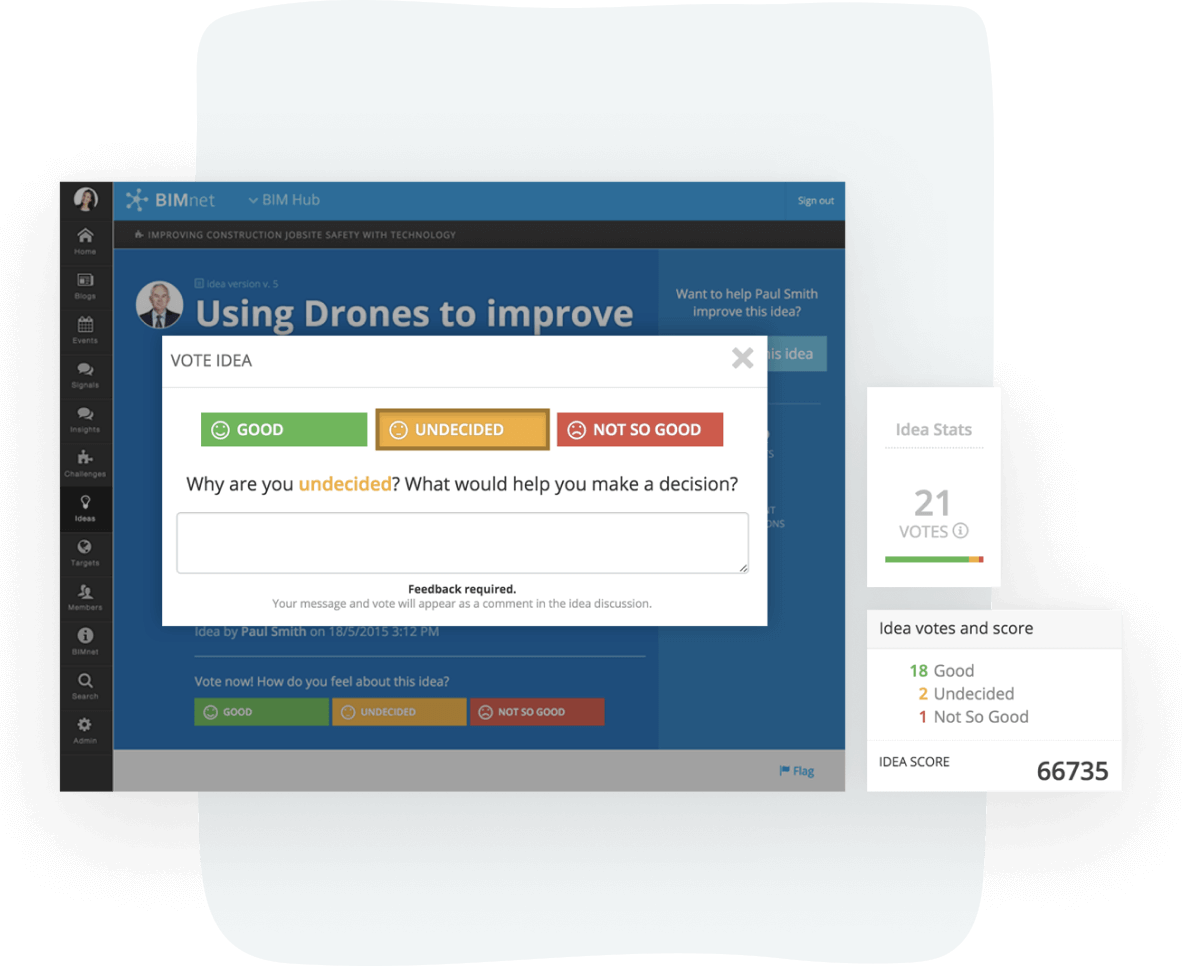
The original author is notified via email about their colleague’s vote and can see the feedback on their activity feed. They can then work together with colleagues to improve their ideas.
Read more: How to Encourage Innovation in the Workplace
3. Idea Evaluation
Once ideas are refined, they go through an idea evaluation model — a set of questions evaluators ask themselves to gauge an idea’s level of risk, feasibility, and potential impact.
Although the exact model you use depends on the nature of the idea and your organization’s process, an evaluation model we see work well across a range of different ideas is RICE:
Reach: How many people can this idea impact?
Impact: What effect can this idea have on the company?
Confidence: How confident are you in your ability to execute this idea?
Effort: How much effort is required to implement this idea?
For continuous improvement ideas with little risk and high certainty, evaluators will use their subject matter expertise and experience to answer these questions. When they greenlight the idea here, it goes directly to implementation.
However, for ideas with more risk and uncertainty, it’s almost impossible for idea evaluators to answer these questions without data backing it up. For example, if they are evaluating a new product idea, they won’t know whether there’s demand from the customer base (unless they work in marketing or the marketing team sends them customer data).
To get the necessary data, idea evaluators will use business scorecards, which contain statements about an idea’s impact, risk, and feasibility as well as tasks that must be completed to approve or disapprove these statements. Idea evaluators will assign scorecards to employees with specific competencies, and they’ll complete these tasks to verify the statement on their scorecard.
How InnovationCast Helps Evaluate Ideas
InnovationCast comes with several idea evaluation workflows containing the criteria, evaluation models, and scorecards that evaluators can use to understand whether to approve an idea. They aren’t left alone to decide what criteria and evaluation models to use.
Depending on the type of idea being evaluated, the risk level associated with it, and the potential value, InnovationCast suggests different tasks, criteria, evaluation models, and people to be involved.

This way, idea evaluators know what boxes an idea needs to tick and who needs to be called in to move it forward. They can, of course, customize these workflow steps around their organization’s specific processes; this is as simple as dragging and dropping design blocks.There’s no coding required.
Additionally, because we paid special attention to designing InnovationCast with complete transparency, original authors can view what’s happening to their ideas after they’ve submitted them. For example, have evaluators moved them forward into implementation, tabled them for whatever reason, or asked for more information?
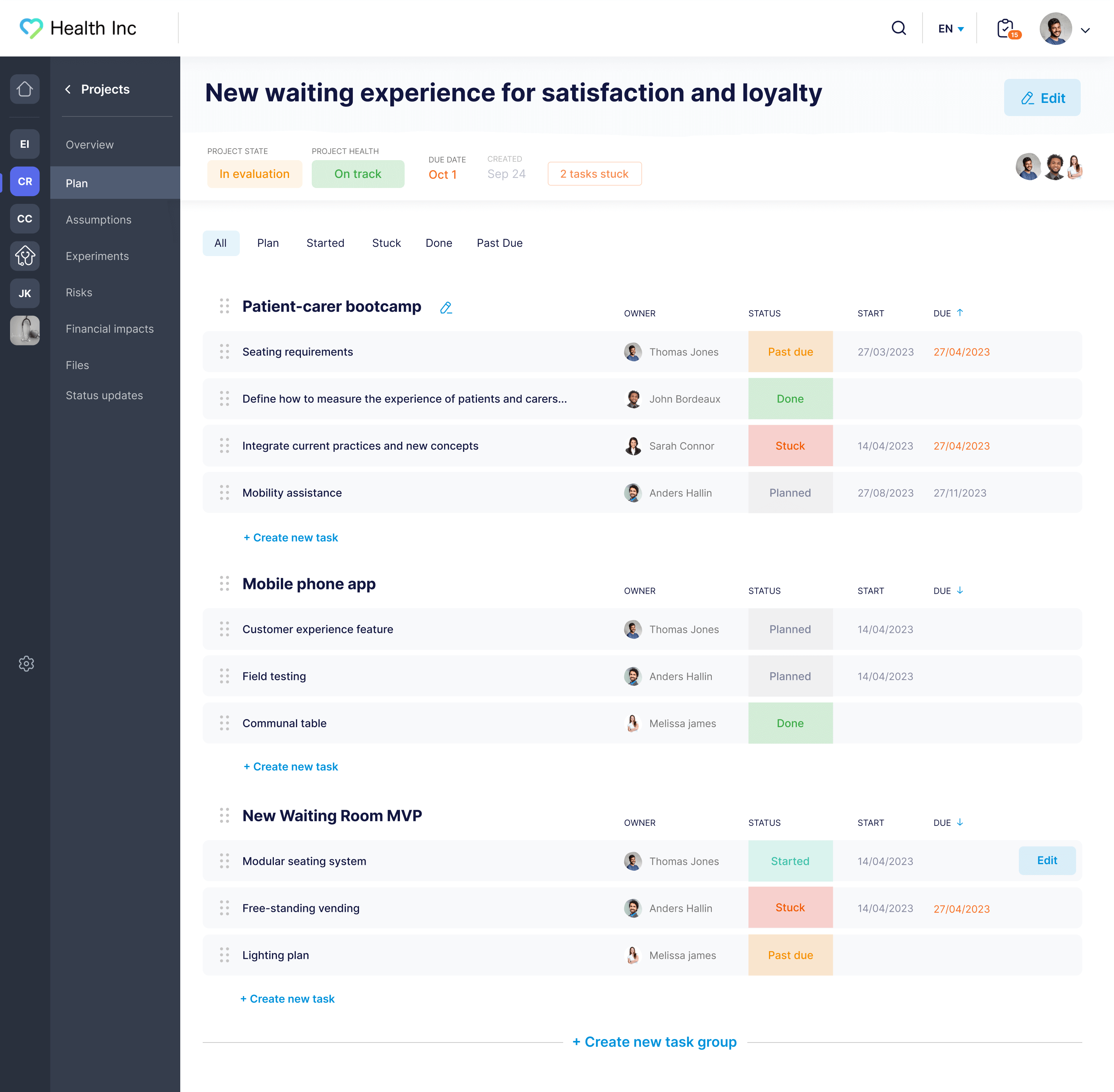
Organizations can obviously restrict visibility to ideas if they choose to. However, we learned that giving original authors complete transparency into their idea’s progress improves morale and keeps them excited to submit ideas. They know their ideas are actually being worked on and not left untouched.
Read more: Best Practices to Evaluate Innovation Ideas
4. Idea Prioritization
Once organizations have evaluated ideas and decided on the next steps, they usually prioritize the order in which to pursue them since they cannot realistically launch every idea at the same time.
The order in which ideas are prioritized will depend on which ideas are likely to have the most impact, involve the least risk, and address the organization's most urgent priorities.
To facilitate the idea prioritization process, department leaders or whoever was in charge of evaluating a set of ideas will ask stakeholders, outside experts, and other decision-makers for their input. Everyone votes on the idea they believe should be pursued first.
How InnovationCast Facilitates Idea Prioritization
InnovationCast allows you to invite decision-makers to the platform, give them insight into the details of each idea, and have them vote on the order to validate and implement ideas.
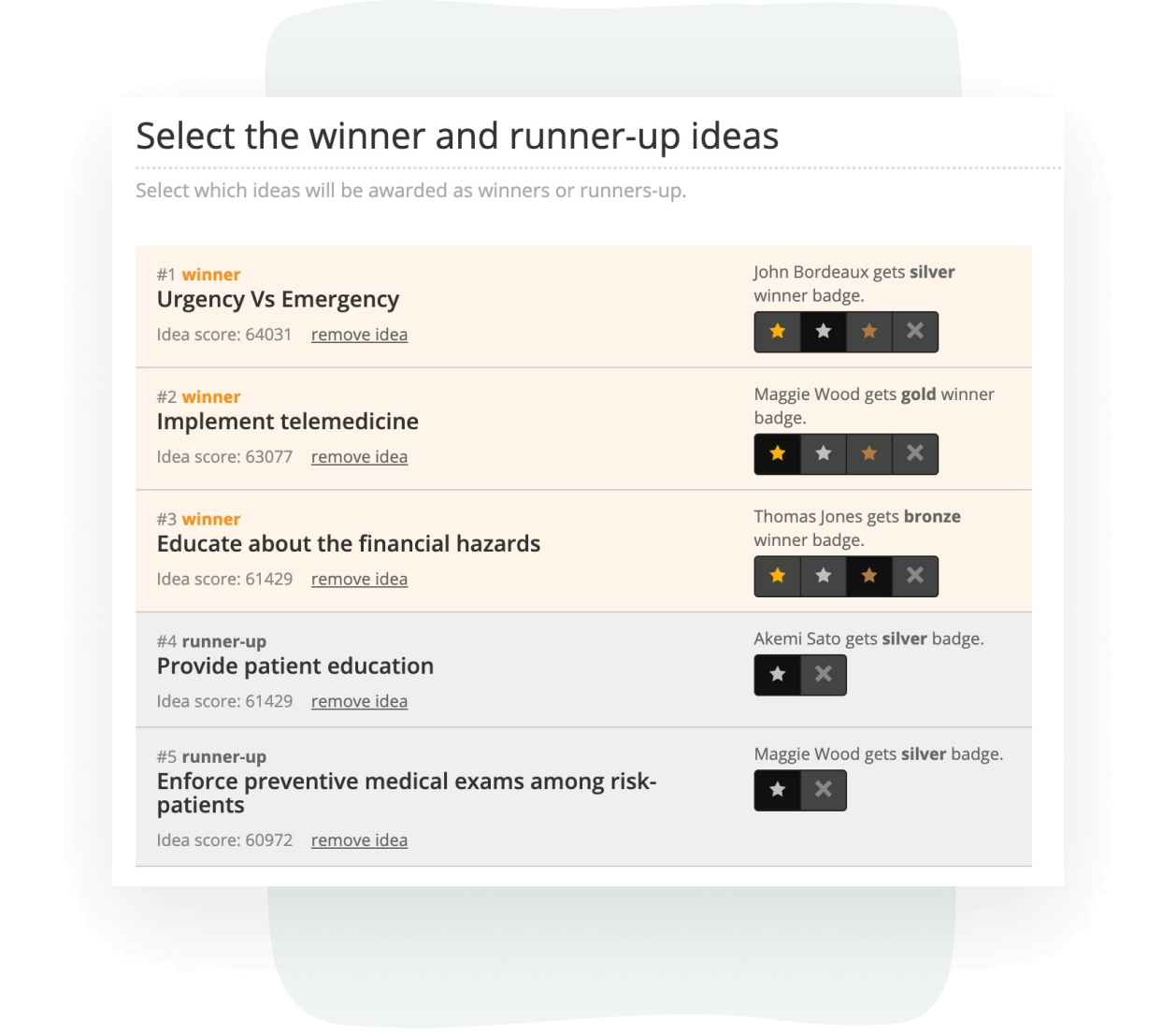
Decision makers can log into their InnovationCast dashboard, and vote on which ideas are “winners” and “runners up.”
5. Idea Validation
Idea validation is a process of testing to understand whether it’s worth pursuing an idea. It involves mapping out assumptions about what must be true for an idea to work and then conducting experiments to test them. Completing these experiments allows organizations to determine if an idea is worth pursuing.
Most ideas won’t go through this validation step because they are continuous improvements to live products, services, and processes supported by data. For example, product developments based on customer complaints or feature requests fall in this category. They will simply get developed based on existing workflows and go directly to implementation.
However, for higher-risk, lower certainty ideas, there’s more validation required. These include ideas such as a completely new product idea, an innovative business model, or breaking into a new industry.
For ideas like these, innovation or department managers usually need to assemble teams ad hoc and assign them to validate a specific idea. Sometimes, these are employees who volunteer; on other occasions, they need people with specific competencies (marketing, engineering, accounting, etc.).
However, the mistake we see many organizations make is they'll ask employees to use regular project management tools to plan validation tasks.
The problem is that project management tools don’t provide employees with guidance on how to map assumptions, what experiments to run, and how to know if an idea should be implemented. Remember, these employees may be experts in their respective fields, but they probably aren’t well-versed in idea validation.
This leaves validation teams feeling uncertain and figuring things out as they go along. In our experience, this is the biggest reason validation fails.
Instead, we found that organizations with the best validation processes use innovation management software because it includes workflows and frameworks that structure the tasks validation teams must complete.
Effective innovation management software will suggest what assumptions to establish and experiments to use, ultimately aiding validation teams in determining whether an idea should be approved. You don’t get this with traditional project management tools.
How InnovationCast Facilities Idea Validation
To help teams validate ideas, InnovationCast has multiple idea development workflows designed around different kinds of ideas. We have workflows for operational ideas, business model ideas, product ideas, new technologies, digital transformation, and more.
Our workflows provide validation teams with a roadmap for validating an idea and has been inspired by methodologies like Discovery-driven Planning, Lean Startup, Business Model Generation, and Customer Development.
For example, if a team has been tasked with validation of a new product idea, InnovationCast will show them how to map assumptions around what the idea must achieve to be implemented (e.g., there must be demand for the product, we should have the internal talent to build it, etc.).
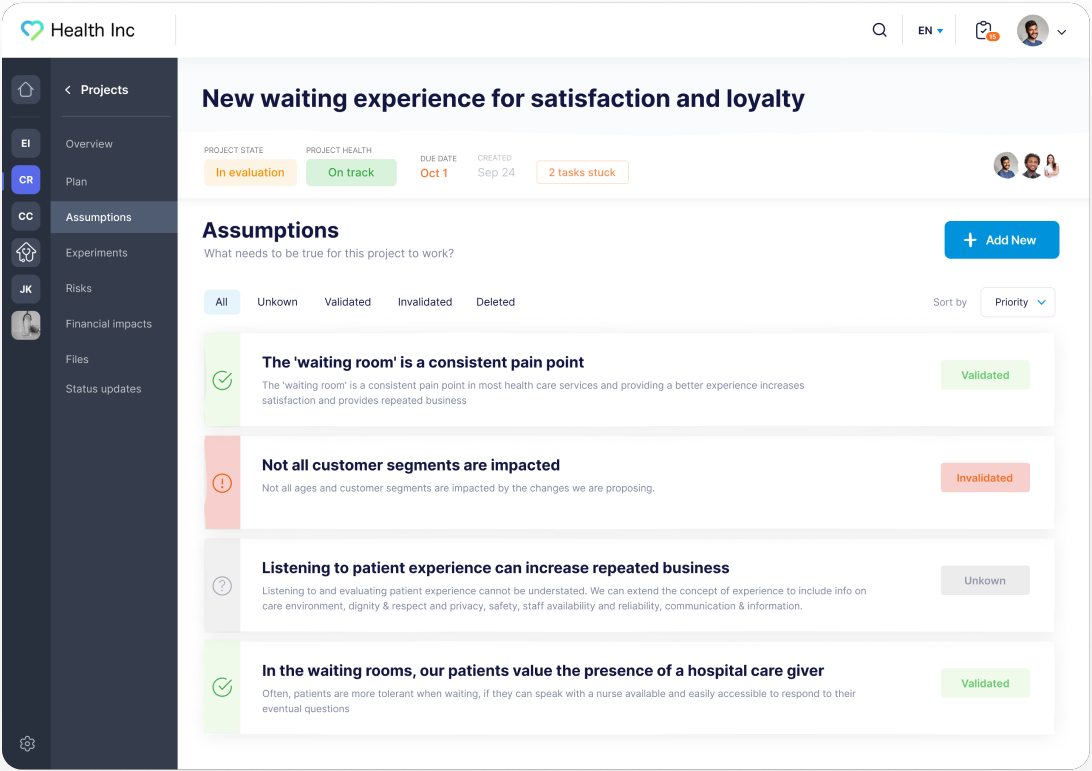
Then, for each assumption, InnovationCast recommends experiments that can help validate it (e.g., run ads to a fake website to test customer demand, use the Wizard of Oz validation technique, release a prototype to early adopters, etc.).
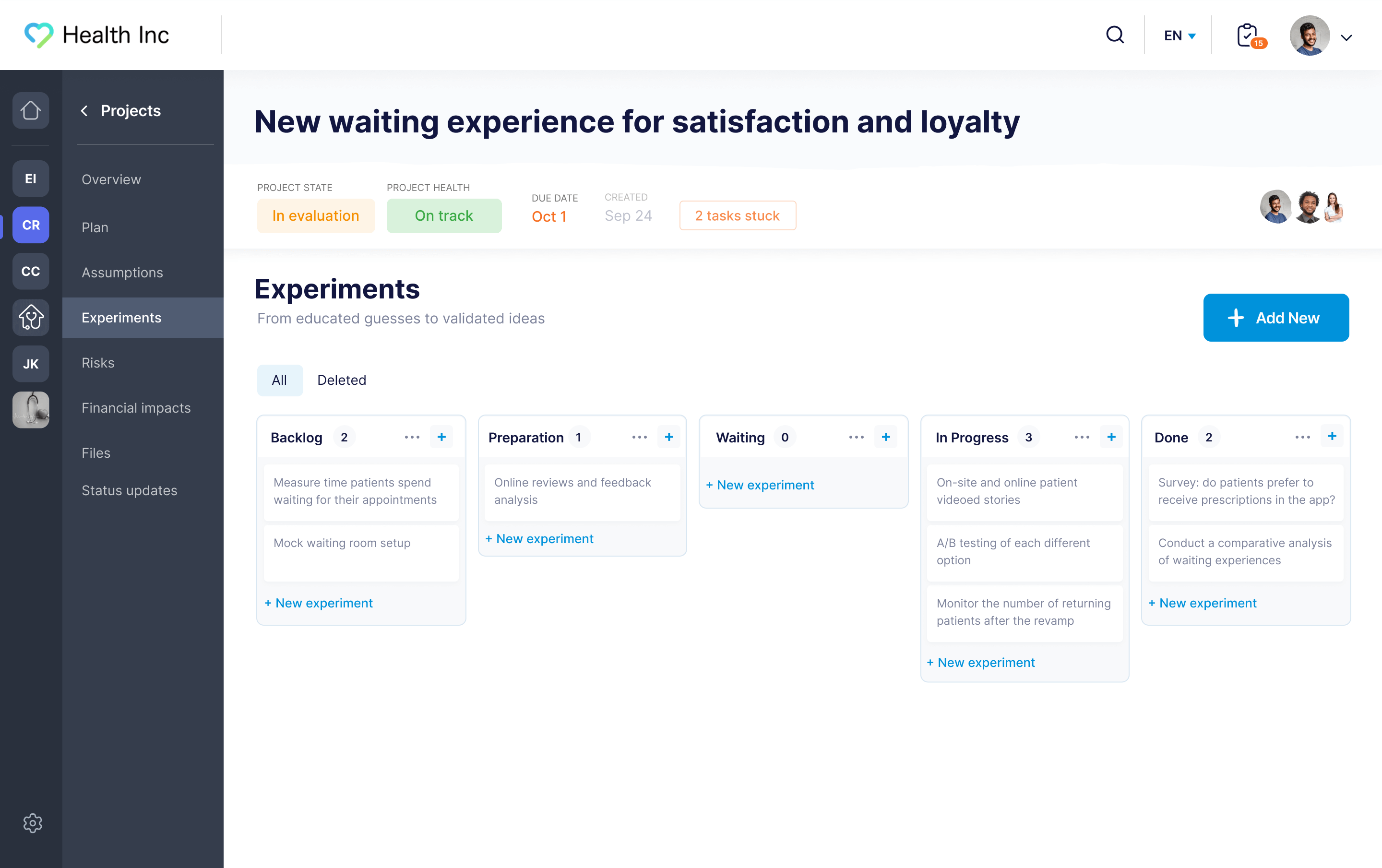
This way, validation teams know exactly what experiments must be completed to validate an idea.
Read more: 5 Best Innovation Tools (2025 Review Guide)
6. Implementation
After risk is reduced to an acceptable level and decision makers have gained confidence in the idea, they are moved forward to implementation.
In most cases, implementation isn’t the innovation team's responsibility. The project management office normally launches the full innovation by creating and assigning implementation tasks to employees, managing the allocation of resources, and establishing timelines.
However, for high-risk, high-uncertainty ideas where there’s still a lot of discovery and validation work happening after the idea is implemented, it’s recommended that the innovation department work with the project management office to launch the innovation.
This is because the innovation department is usually more well-versed in managing risk, learning from live products, services, and processes and using these to improve the innovation.
7. Impact Tracking
The final step involves measuring the new innovation's impact on the organization (e.g., how much revenue it has generated, how much money it saved, how much it reduced client churn, etc.).
While impact tracking is part of the idea’s lifecycle, the innovation department usually isn’t in charge of it. Typically, project managers, data analysts, and marketing teams are responsible for tracking the impact of an idea post-implementation and using this data to fuel decision-making on whether to continue supporting the innovation or discontinue it.
The most common ways organizations measure the impact of innovations is by:
Tracking sales figures and early majority and late majority adoption rates
Conducting customer interviews to learn about customer needs and satisfaction
Sending out customer surveys
Assessing changes in market share and understand how diffusion changes post-implementation
Monitoring changes in employee activity
Tracking defect rates and customer complaints to learn about improvements in the product or service’s quality
To learn more about measuring innovation, read our comprehensive guide:
How to Measure Innovation: Essential KPIs & Best Practices
How InnovationCast’s Ecosystem Facilitates Impact Tracking
InnovationCast allows organizations to measure an innovation’s impact using customizable reporting dashboards or integrating with data visualization tools like Microsoft Power BI, Tableau, and more.
During onboarding, our team will help you set up and customize reporting dashboards around your innovation process and the types of innovations you want to launch.
For innovation programs that are just starting out and may not have innovations to track yet, InnovationCast allows them to track engagement and process metrics to understand how engaged participants are and where ideas are in the innovation process.
Then, for organizations with more mature innovation processes, your team can customize the InnovationCast dashboard to track key metrics, such as:
The number of active projects
New or increased revenue or cost savings generated by an innovation
The number of sales or new sign-ups
Other impacts and value propositions, such as the effect of an innovation on client churn
Get Started
InnovationCast has helped organizations like DHL, ING, Visa, and Novo Nordisk establish the steps to move ideas through their lifecycle. For example, we helped DHL establish an entire innovation process in just four weeks. This resulted in a 67% increase in idea submissions and a 14% increase in successful innovations.
Book a quick demo with our team to see how we can do something similar for your organization.
Related reads:

